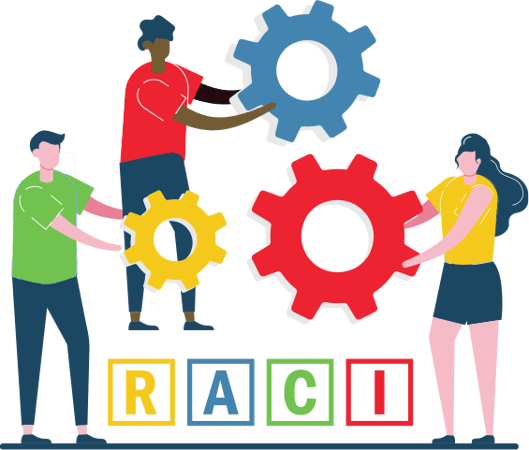 Clients often puzzle over the relationship between job descriptions and RACI charts. Are they the same? Which one should I create first? Can I use a RACI exercise to improve my job descriptions? At the heart of the matter there are usually concerns about accountability in the company and the hope that using RACI will clarify roles and strengthen accountability.
Clients often puzzle over the relationship between job descriptions and RACI charts. Are they the same? Which one should I create first? Can I use a RACI exercise to improve my job descriptions? At the heart of the matter there are usually concerns about accountability in the company and the hope that using RACI will clarify roles and strengthen accountability.
So this post will tackle each one of these questions.
1. Is a Job Description the same as a RACI?
No, they are quite different and complementary. Typically, job descriptions focus on the individual job and its responsibilities. Sometimes the job description tries to address how the individual fits into a larger system. But the language usually remains conceptually broad and vague: “will collaborate with” or “will support” are two examples. Job descriptions usually try to help people understand their accountabilities, but seldom call out specific decisions that people have the authority to make.
The key is to remember that most often job descriptions focus on describing individual responsibilities.
RACI charts, by contrast, are systems tools. By definition a RACI describes the relationship between the individual and others. This is why the tool is so powerful in clarifying cross-functional communication and roles.
RACI describes the relationship between the individual and others.
2. Can I do a RACI for an individual job description?
No, not in isolation. You can list every one of the individual’s responsibilities from their job description and assign them an R, but that’s not very interesting by itself. More valuable is calling out specific decisions that your job holder participates in. Do they have the A? Will their advice be solicited because they have the “C”? Getting this clear can really reduce interpersonal friction.
RACI’s only get interesting when you start adding in the other stakeholders.
3. Should I change the job descriptions or the RACI charts or both?
In my experience, business moves a lot faster than job descriptions evolve, which is why job descriptions should be written more generally. Imagine that you’re showing up for your first day of work, having studied your job description carefully. First thing, you get assigned to 2 project teams that weren’t mentioned in your job description, and now that work is part of your day to day work life. This is typical.
RACI’s are often linked to project work and to cross-functional work. By design, they are supposed to be revisited regularly, and be fluid. When people come and go on a project, or when project demands change, it's good to do a quick new RACI to clarify roles again.
Job descriptions are static; RACI charts are dynamic.
4. Which should we create first, job descriptions or RACI charts?
Where possible, create your RACI charts first, because once you clarify the relationship between people and between departments, it will effect what you put into the job descriptions. You don’t need to RACI every last thing, which would be a massive undertaking. DO create RACI charts for the cross-functional “pain points” whether those are inside one department or across the organization.
Just remember that your job descriptions don’t have to be “up to the minute” current, but your RACI charts should be.
About RACI Solutions
RACI Solutions has been helping organizations across the globe utilize the power of RACI to transform the dynamic of cross-functional teams since 2007. Whether you are new to RACI or have used it for years, we can help.
Today’s business environment is complex – you may be contending with matrix structures, rapid growth, mergers, multiple locations, virtual employees, and/or digital transformation.
As a result, project teams can get stuck. Let us help you! If you need to learn RACI, we offer train-the-trainer materials and custom workshops. We can help you create RACI super-users. If you already use RACI or another decision matrix, we offer programs that help you become skilled at working across functions – an effective horizontal leader. We help project teams tune up their performance. We help organizations streamline their decision-making.
Our team is comprised of expert consultants, trainers, and facilitators, who can help your teams and their leaders achieve a seamless level of collaboration.





